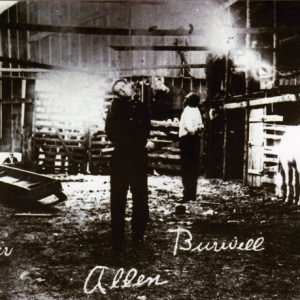calsfoundation@cals.org
James Brown (Jim) Miller (1861–1909)
James Brown (Jim) Miller was an Arkansas native but spent much of his life in Texas and Oklahoma, where he earned the reputation of a professional assassin, manipulating the court system to avoid prison. From his early years in Van Buren (Crawford County) to his death in Ada, Oklahoma, Miller proved to be a man to be feared.
Jim Miller, the eighth of nine children of Jacob and Cynthia Miller, was born near Van Buren on October 25, 1861. His father was a miller and, at times, a stone mason by trade.
Miller received the typical education of the times, and nothing stands out in his life until the family relocated to Coryell County, Texas. The exact year of this move is unknown, but on July 30, 1884, he killed his brother-in-law, John Coop. Found guilty, Miller appealed the verdict, but a second trial apparently never took place, and he was not incarcerated. It was the first of many killings committed by Miller for which he avoided punishment.
Miller married Sarah Francis “Sallie” Clements in 1888 in McCulloch County, Texas. Three of their four children survived to adulthood.
In the twenty-five years between Miller’s first known killing in 1884 and his last in 1909, he murdered between fifteen and fifty-one men (the latter number taken from his own admission), mostly for hire. Oklahoma adjutant general Frank Canton stated that, to his “personal knowledge,” Miller had killed thirteen men in Texas, which raises the question as to the number of men he may have killed in Oklahoma and possibly New Mexico as well.
Several of Miller’s killings are without controversy: he killed Sheriff George A. “Bud” Frazer on September 14, 1896, in a Toyah, Texas, saloon; earlier that year, while serving as a deputy under Sheriff Frazer, he killed a prisoner who was “attempting to escape.” He also certainly killed T. D. “Frank” Fore on March 10, 1904, in Fort Worth, Texas, and Indian policeman Ben C. Collins on August 1, 1906. On February 29, 1908, famed lawman Pat Garrett, the slayer of Billy the Kid, was killed under mysterious circumstances. Whether Miller was the actual slayer or merely part of the murder conspiracy remains controversial.
On February 27, 1909, Miller killed former Oklahoma deputy U.S. marshal A. A. “Gus” Bobbitt near Ada. Lawmen suspected Miller, and after investigation, Miller and three of his associates were arrested and placed in the Ada jail. In the early morning hours of April 19, 1909, a mob overpowered the two jailers, took Miller, Joe Allen, Jesse West, and Berry Burrell to a nearby livery stable, and lynched them. A photographer was called in, and his photograph of the four men hanging has become an icon in the lore of the Old West. Miller was buried in Oakwood Cemetery in Fort Worth, Texas.
Miller never officially joined or led a gang, although occasionally he did associate with men who were disreputable and perhaps criminals themselves. In contrast, however, Miller prided himself on his image. He joined churches in the various communities in which he lived and developed friendships with the communities’ most reputable citizens. This proved to be part of his manipulation of others, for if charged with any illegal acts, he had a ready-made coterie of “pillars of the community” to provide him with testimonies of his respectability. Why Miller turned to his career of killing is undetermined, although he may have simply been a psychopath. Further, the various nicknames given to Miller all became commonly used by writers only after his death. During his lifetime, the only documented cognomen given him was “Kid.” Such nicknames as “Deacon Jim,” “Killer Miller,” and “Killin’ Jim” have no basis in the contemporary records.
In 1997, a monument was erected near the site of the livery stable commemorating what was termed “The End of the Old West.” On April 19, 2009, a controversial program was held at the monument to commemorate the passing of the four men whose deaths 100 years earlier had marked the transition between lawlessness and established law and order in the Old West.
For additional information:
Hope, Welborn. Four Men Hanging: The End of the Old West. Oklahoma City: Century Press, 1974.
James, Bill C. Jim Miller: The Untold Story of a Texas Badman. Wolfe City, TX: Henington Publishing Co., 2001.
Parsons, Chuck. James Brown Miller and Death in Oklahoma: Was Justice Denied in Ada? Gonzales, TX: Reese’s Print Shop, 2009.
Shirley, Glenn. Shotgun for Hire: The Story of “Deacon” Jim Miller: Killer of Pat Garrett. Norman: University of Oklahoma Press, 1970.
Chuck Parsons
Luling, Texas

 Jim Miller Family
Jim Miller Family  Jim Miller Grave
Jim Miller Grave  Jim Miller Lynching
Jim Miller Lynching 



Much has been written about Jim Miller. And it could all be true, except this account of how Augustus Bobbitt died. I advise careful consideration of vigilantism and an ego contest between Chickasaw Indians and U.S. marshals. Don’t judge this man on the death of Augustus Bobbitt.
My grandfather told me about the hanging pictured in the photo of “Four Men Hanging” almost thirty years ago, and I am trying to find more information about it. I am interested in the owner of the white horse in the foreground. I have been told that it may have belonged to my great-grandfather. My grandfather also told me that when he was a child, he was directed not to look into the alleys or side streets when walking through town. I think they lived in the town of Allen, a short distance from Ada.